
Vertical cuttings dryer is the main machine used to treat oil base mud drilling cuttings. It is normally used together with high speed decanter centrifuge, screw conveyer and Thermal Desorption unit.
GN brand Vertical Cutting Dryer utilize centrifugal force to treat drilling cuttings. For other brand vertical cuttings dryer, they can only treat oil base mud or or synthetic base, they cannot be used to treat water base mud. GN brand vertical cuttings dryer. with its patent design, can treat both water base mud and oil base mud, as well as synthetic base mud. And it can be used in most critical condition jobsite.
A stainless steel screen bowl traps “wet†solids and rotating them up to 900RPM with G force up to 420. Liquid is forced through the screen bowl openings, while “dry†solids are extracted by the angled flights attached to the cone, which rotate slightly slower than the bowl. Tungsten carbide protects the flights from abrasive solids and ensures long operational life. This aids in maintaining a constant gap between the scroll and screen bowl, which is crucial for proper operation. GN cutting dryer has been done strict balance testing for all major rotary components to minimize vibration & noisy.
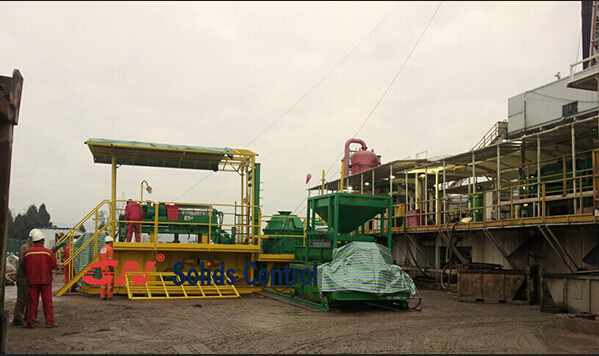 |
Vertical cuttings dryer for oil base mud
As the necessary machine to treat oil base drilling cuttings, vertical cuttings dryer can reduce the oil on cuttings to 3~5%. Per Job site report, GN Second generation vertical cuttings dryer can reduce OOC (oil on cuttings) to 3.7% or less. It can greatly release the upstream processing machine capacity.
Compared with oil base mud, water base mud drilling cuttings is more critical for treatment. It is easy to block the screen basket and cause machine stop. GN second design vertical cuttings dryer with pressed air knife system for flushing the screen. It can be used to treat water base mud drilling as well. And the performance have been approved by job site test.
Customer can visit GN web site for job site video.
Video: GN Oil Based Drilling Cuttings Dryer for Shell Project
http://www.gnsolidscontrol.com/video/gn-oil-based-drilling-cuttings-dryer-shell-project
Video:GN Vertical Cuttings Dryer for water based mud drilling waste Management
http://www.gnsolidscontrol.com/video/vertical-cuttings-dryer-water-based-mud-drilling-waste
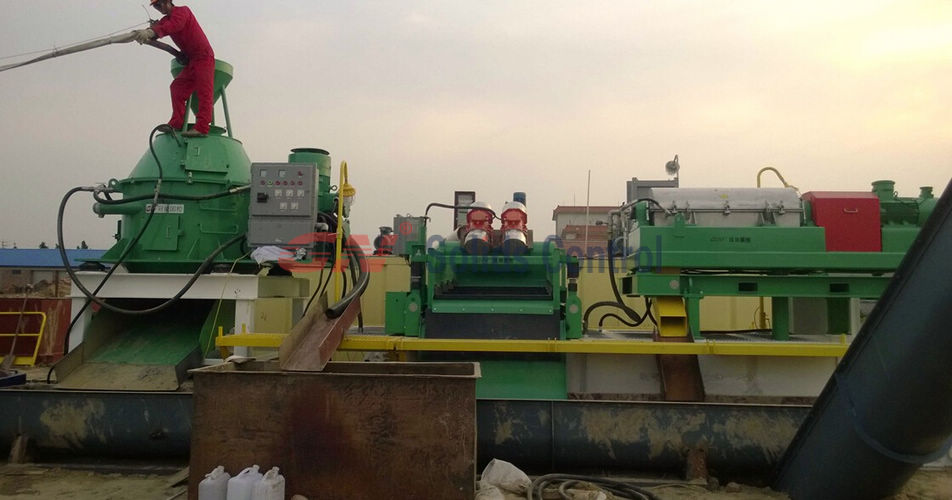
High G shale shaker can also used to treat water base mud. But it is not dry enough. With the high speed rotating, GN second generation vertical cuttings dryer GNCD930C can reduce the water on cuttings to a lower rate and make it easy for trailer movement.
- Details
-
Published: 06 December 2014
GN Solids Control, as China top solids control manufacturer, exported 4 complete sets solids control equipment for 1000hp land drilling rigs to an North America drilling company. The drilling company also includes some replacement equipment for their previous land rig mud systems.
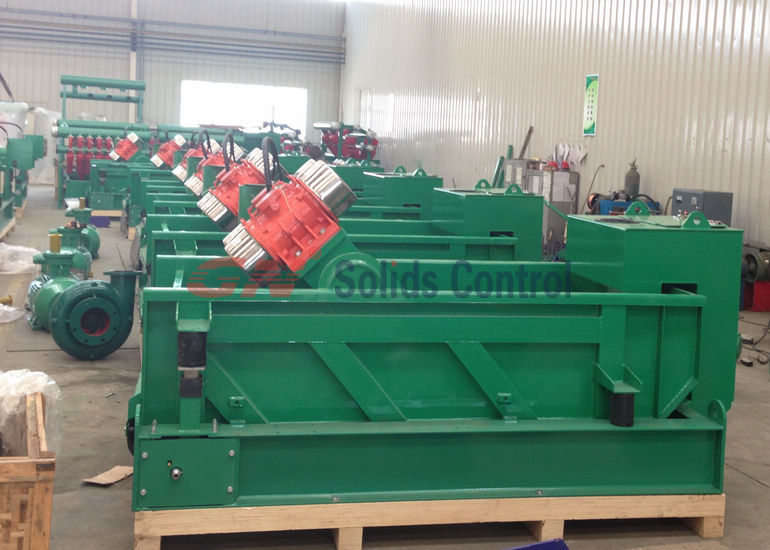
The order includes below solids control equipment:
1) Linear motion shale shaker model GNZS594E-HB, quantity 10 each
2) Vacuum degasser GNZCQ270A, Quantity 4 ea
3) Desander mud cleaner, quantity 5 ea
4) Desilter mud cleaner: quantity 7 ea
5) Different models centrifugal pumps, quantity 25 ea
6) Mud agitator, quantity over 40 ea
7) Other replacement spare parts.
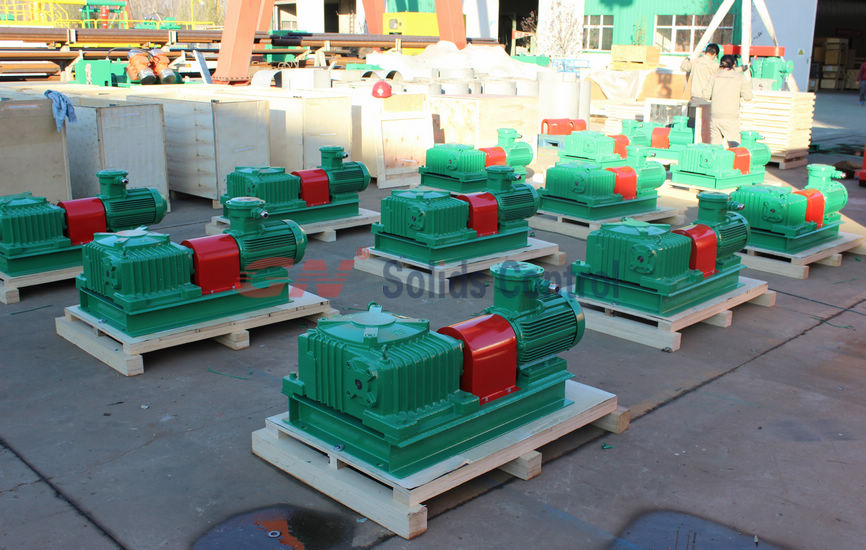 |
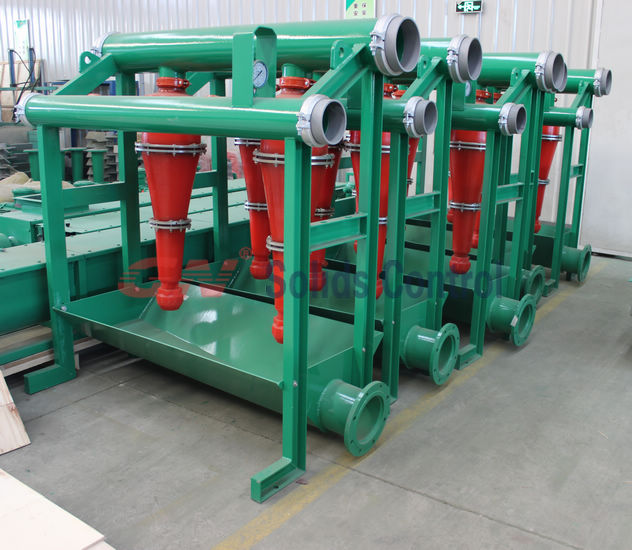 |
There are so many companies in China and out of China, why the customer finally choose GN after comparison?
1) GN Solids Control is the 1rst API certified solids control company in China. Now GN have CE certificate approved by DNV for European market.
2) GN is the first China solids control manufacturer who registered in Houston America and have a separate brand GN Solids America. All GN equipment made per international high standard.
3) GN company mission: Top brand and reasonable price. No lower, no higher.
4) As the fast developing company, GN think highly of customers’ feedback and keep improving quality and design.
5) GN centrifugal pump interchangeable with NOV mission pump. It makes customers easy for replacement and for stock spare parts.
6) GN have shaker model interchangeable with Swaco Mongoose and Derrick.
Besides mud solids control equipment, GN also make drilling cuttings treatment equipment.
GN offer one-stop solution for drilling rigs.
Below is the main drilling waste management equipment GN makes:
1) Drilling cuttings screw conveyer
2) Vertical cuttings dryer for both oil base mud and water base mud. The performance approved by jobsite test. While other brand, they can only be used for oil base mud.
3) High G drying shaker for water base mud
4) Big bowl decanter centrifuge and super high speed centrifuge
5) Dewatering unit for waste water treatment or water base mud treatment.
- Details
-
Published: 21 November 2014
Decanter centrifuge is an important and relative cost high equipment in solids control and drilling waste management equipment. It has an important role on the total system performance. There are so many companies announced for decanter centrifuge manufacturing, especially in China. But do you know how to choose the right one for your drilling waste management project?

As the first China solids control manufacturer who have warehouse in Houston, GN Solids Control give suggestions as below:
1) Check the parameters: To check if the offered centrifuge can meet your request.
2) Check the company’s project list, to make sure they have experience on your field. If you are searching for a centrifuge for drilling cuttings treatment, companies who make centrifuge for pharmaceuticals industry, food industry or solids control should not be suitable. If possible, to talk with the people who used their equipment or to check their jobsite.
3) To check the centrifuge material: For drilling waste management, centrifuge materials should be the highest ranking. It should be very strong and good performance for anti-abrasive.
Bowl material: Duplex Stainless Steel 2205 by centrifugal casting is the best. Derrick centrifuge and Swaco centrifuge made by it. It is excellent and reliable. SS316L is the second option. While SS304 and SS302 not recommended.
4) Screw protection: best option is interchangeable Tungsten Carbide Tiles. Second option is ceramic tiles if your budget is very tight, or just want a cheaper one. Hard surface welding for screw project is not recommended.
In the first year or half year, there maybe not much difference, but after 1 year, the hard surface welding will be worn out. It is difficult for maintenance, and you have to make balance again after welding repair. But the interchangeable tiles, you only need to remove the broken one and change it with a new one.
5) To check the companies’ facility and capability. Centrifuge manufacturing have a high standard request on manufacturer’s capability. It you intend to order from a company, it is better you pay a visit to their company, to check their workshop, see which material they use, how they make, which kind of processing machine they have. CNC machine and Five-face processing machine, dynamic balance machine is the necessary for centrifuge processing.
6) VFD Control panel: Possitive pressurized VFD panel with self-cooling is necessary. Flameproof cannot cool down and cannot exactly meet the EX standard. 3 VFD for main drive motor, back drive motor and feeding pump also the best. If there is PLC for smart control, perfect.
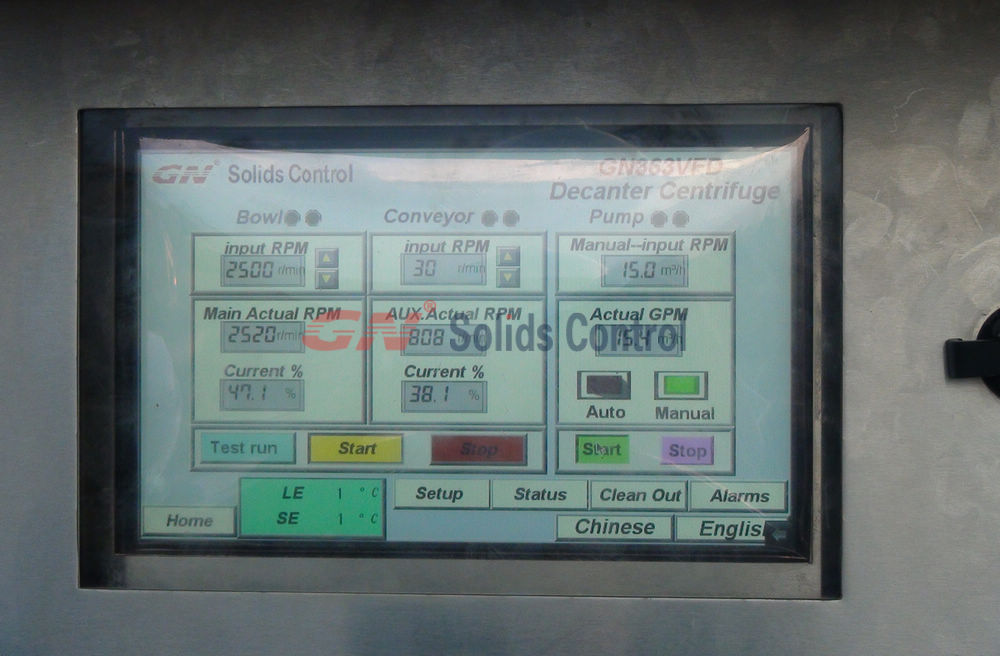
7) To check the price: The lowest price surely can be considered. If the price is even much lower than the market average, where they get benefits? Surely the quality cannot be good.
8) To check besides decanter centrifuge, what other equipment they can make for drilling waste management, like high G dryer shaker, screw conveyer, dewatering unit... If they can meet all above, and they can offer you complete solution on drilling cuttings treatment.
If there is a company can meet all of them, then you can consider. If you have any other questions on solids control equipment or drilling waste management, welcome you contact GN Solids Control freely.
- Details
-
Published: 01 November 2014
Water base drilling mud is one of the most popular drilling mud in oil and gas drilling field. Compared with oil base drilling mud and synthetic base drilling mud, water base mud have a lower pollution on environment, it is relatively lower cost, and easier to generate the drilling waste.
Draftly speaking, there mainly 2 kinds of system will be used to water based mud in oil and gas drilling field: mud Solids control system and drilling waste management system. 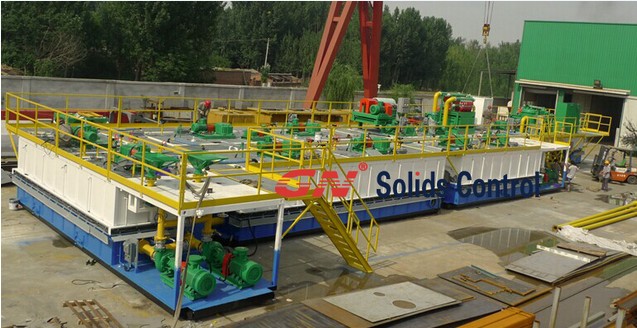
Solids control equipment for water base drilling mud management system
1) The first stage solids control equipment shale shaker, recommend model GNZS549E
2) The second and third stage solids control equipment mud cleaner. It is a combination of desilter, desander and under flow shale shaker for compact design. Customer can choose different model mud cleaner per drilling capacity request. Sometimes per different jobsite request, customer can even choose separate desilter, desander with or without underflow shale shaker.
3) The fourth stage solids control equipment decanter centrifuge. In this stage, the jobsite normally use lower speed 1800~2200rpm for barite recovery, and/or a high speed centrifuge for fine solids control.
Drilling cuttings treatment system for water based mud
1) High G dryer shale shaker, model GNZS594HGE. It is a four-panel shale shaker with the same replacement shaker screen with Swaco Mongoose shaker.
2) Decanter centrifuge high speed for drilling waste management, with a telescopic skid underneath
3) Screw conveyer to transfer drilling cuttings
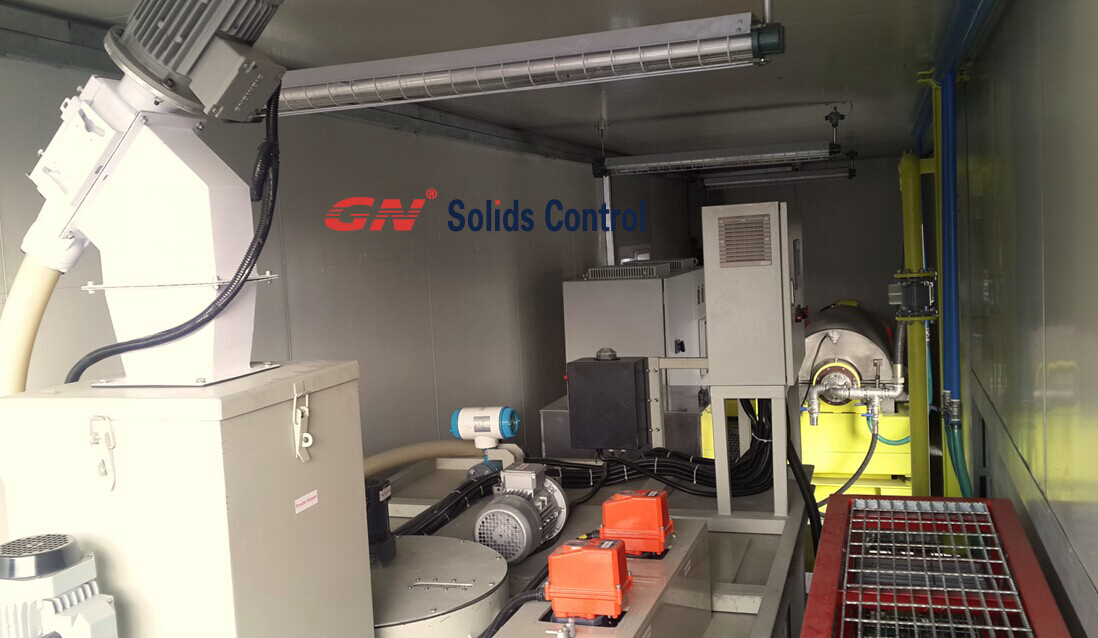 |
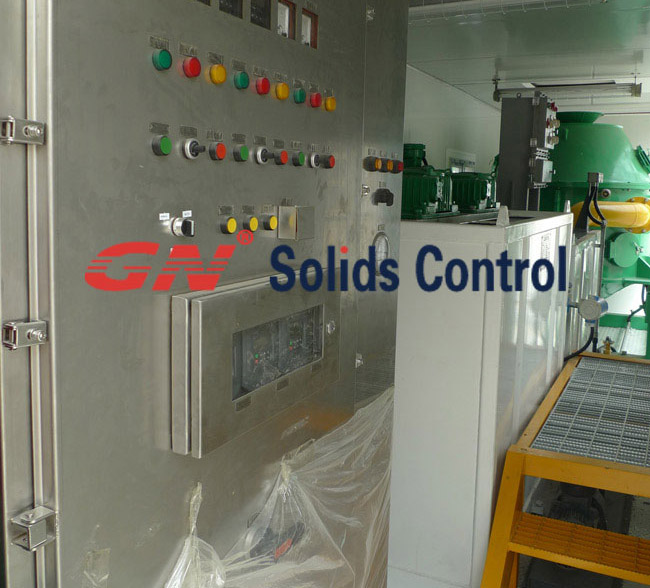 |
In some cases, if there are too much fine solids in the fluids phase from drilling waste centrifuge, and it cannot be separated by decanter any more, dewater unit will be used.
Dewatering unit with dewatering centrifuge is a normally used for water base mud drilling cuttings treatment. It is used to supply chemicals to polymerize the fine solids into bigger size that centrifuge can separate.
After solids control separate, drilling waste separate, and/or dewatering treatment, the clean fluids can be transferred to mud tank system for drilling. Or if there is no drilling activity, the fluids can be transferred direct to slurry separation company for waste water treatment.
- Details
-
Published: 25 October 2014
GN Solids Control is one of the most professional manufacturer for mud solids control system and drilling waste treatment system for drilling filed. GN offers complete solution for oil and gas drilling, horizontal directional drilling (HDD), coal bed methane (CBM) drilling, piling, micro tunneling, water well drilling and other underground construction activities.
Recently, GN Solids Control company made a complete mud cleaning system for Coal Bed Methane (CBM) drilling for East Asia market. The CBM rig mud system consists of double deck shale shaker, mud cleaner with only desander cone, dewatering unit with decanter centrifuge for dewater unit. The total system can control the solids content effectively, normally, after GN CBM mud system, the solids separation can be reduced to 5μm ~ 15μm. The GN CBM mud system can also mix qualified drilling mud for the CBM drilling rig. The system can increase the drilling speed and prolong lifetime of the mud pump and drilling rigs. Combined with GN drilling waste management, GN CBM drilling mud system can generate minimum drilling waste to reduce the effect to environment.


Equipment list and the treatment process of the CBM drilling mud system
1) Double deck shale shaker model GNZS705E
The first shaker deck use steel screen with size 1mm to separate coarse particles over 1mm. The solids discharge and transferred by screw conveyer. Clean fluids falls down to the bottom deck and further separated by fine screens of the bottom deck and then fall into mud tank.
2) Mud cleaner GNZJ703E-3S. The mud cleaner with a big shake GNZS703E, and with only desander cone, without desilter cone. After separated by the desander cone, clean fluids enter into mud tank and mud tank.
3) 40ft containerized Dewatering unit with 3 compartment for continue flocculate. The whole flocculate system mounted into a 40ft fabricated container, complete with a decanter centrifuge big bowl GNLW553VFD and a feeding pump for the centrifuge.
For more information of GN CBM drilling mud system or GN dewatering unit or any other equipment, contact us freely.
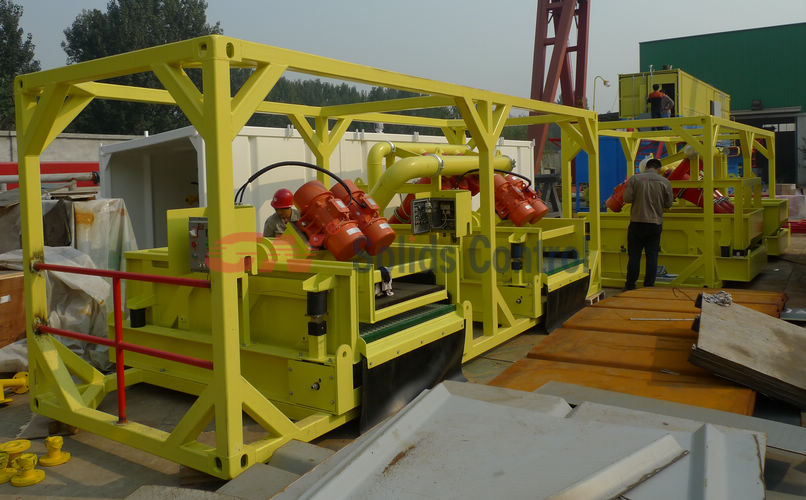
- Details
-
Published: 11 October 2014
Decanter centrifuge is widely used for different field and applications. GN Solids Control (GN Solids America) is a worldwide manufacturer for mud solids control equipment and drilling waste management equipment. Decanter centrifuge is the most powerful and advantaged products of GN Solids Control.
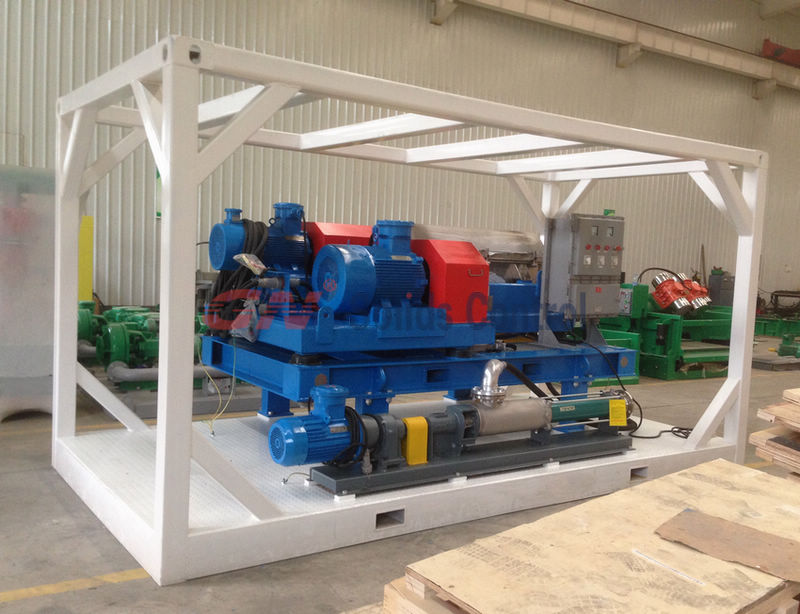
Below are some applications of GN brand decanter centrifuge:
1) Diamond drilling and coal bed drilling
2) For waste water treatment
3) For low gravity solids separation and high gravity solids separation in drilling rig site, like barite recovery and fine solids separation
4) Drilling waste management system
5) Water/Oily Waste Treatment
Recently, a customer request decanter centrifuge system for water / oily waste treatment. After face to face talk with customer for their request , and per his jobsite condition, GN engineering team recommend 2 centrifuge packages for the customer:
1) Decanter centrifuge for Water/Oily Waste Treatment
It is composed of big bowl centrifuge and feeding pump
1.1) Centrifuge model GNLW453VFD. It is a big bowl centrifuge for big volume capacity. The centrifuge is with bowl size 18’’
1.2) Feed pump for the Big bowl centrifuge GNG60A-150
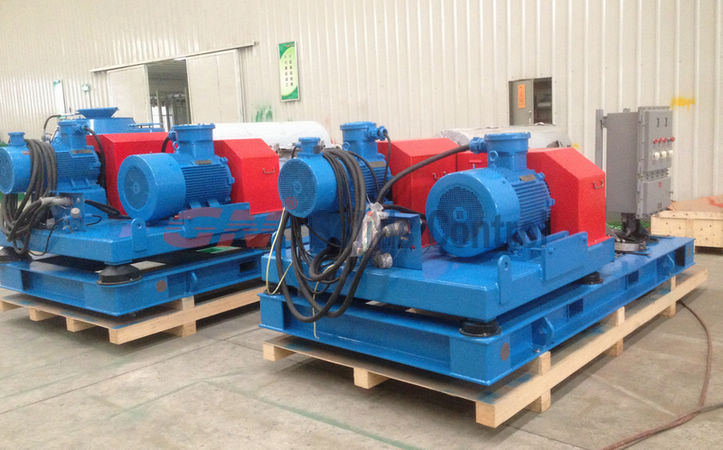
2) Centrifuge for Water/Oily Waste Treatment lower capacity for mobility
Vary from the big volume Water/Oily Waste Treatment system, GN made a combined centrifuge packages, It is components of a 14’’ normal size decanter centrifuge, centrifuge feeding pump and a portable frame to combine all the items.
1) 14’’ centrifuge model is GNLW363BG-VFD, it is GN high standard for international market.
2) Feeding pump for the centrifuge is GNG30A-075, the pump is from German brand company: Netzsch.
3) A Skid mounted frame, centrifuge, VFD control panel and feed pump all mounted on the skid. It is fast for the customer to lift the whole package on trailer skid for fast movement.
This package with a small capacity then 18’’ centrifuge and the centrifuge is also small size. The whole package can be put into container for international vessel shipment.
Beside the Centrifuge packages for Water/Oily Waste Treatment, GN can make other customized package and system for different applications, like HDD system, CBM system, mud solids control system. If you have any question, welcome you contact GN group freely.
- Details
-
Published: 28 September 2014